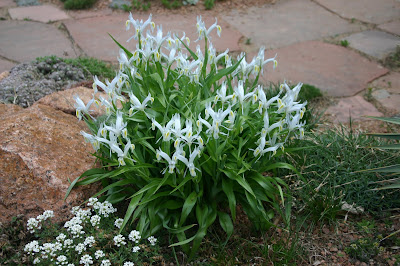 I have only met one person who told me he didn't like Juno iris. I don't think he really knows Juno iris. Most people who've seen or grown a few are usually smitten with their grace and variable beauty. This giant section of the genus (over 50 species) grows from the Mediterranean in the far West all the way to Central Asia in the east, with the largest number concentrated between the Caucasus and Tien Shan mountains: friendly territory like Iran, Afghanistan and suchlike.
I have only met one person who told me he didn't like Juno iris. I don't think he really knows Juno iris. Most people who've seen or grown a few are usually smitten with their grace and variable beauty. This giant section of the genus (over 50 species) grows from the Mediterranean in the far West all the way to Central Asia in the east, with the largest number concentrated between the Caucasus and Tien Shan mountains: friendly territory like Iran, Afghanistan and suchlike. There are a number of species that are very tiny high alpines, and a few giants of the steppe, but most come in that handy size between 6" and a foot. Unlike other irises, that often are fussy and need to be divided and sited perfectly, junos in Colorado grow almost anywhere provided they are not overwatered or too shady. They come in virtually all the colors that iris have perfected: especially blues and yellows, although some approach deep violet purple and there are lots of whites, near orange species and many that combine different colors in a single blossom.
This picture captures the intricate dance of a mature plant: I believe it's Iris vicaria, collected as a bulb in Central Asia by Josef Halda and given to me almost 20 years ago: it thrived in this spot for fifteen or more years until I sold the house where it grew: I divided it into several dozen pieces (I think there may have been over fifty chunks) and moved them to my new house where each and every one seems to have prospered and should be putting on a brave show in 3-4 months. A few kinds are out as early as February some years. Tony Hall, long time curator of the Alpine House at Kew has been working on a monograph of this section in his retirement: when it comes out, it is sure to generate even greater interest in the group: now's the time to stock up on species!




ZOMG, that is one little BEAUTY! Thanks for posting about this...I've never heard of it before but it sounds a real treat. Soooo, where does one purchase such treat??? I would love to try this in the Pacific Northwest.
ReplyDeleteIt's pretty widely available through specialty bulb catalogues (Odyssey Bulbs in Michigan may be the best shot, but there are actually dozens): or remind me next September and you may get one in the mail (I have plenty of offspring, believe me!)
ReplyDelete